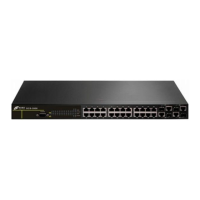181
DCS-3950 series Ethernet switch manual
Command mode: Interface Mode
Default: By default, the port cost is relevant to the port bandwidth.
Port Type Default Path Cost Suggested Range
10Mbps 2000000 2000000~20000000
100Mbps 200000 200000~2000000
1Gbps 20000 20000~200000
10Gbps 2000 2000~20000
For the aggregation ports, the default costs are as below:
Port Type Allowed Number Of
Aggregation Ports
Default Port Cost
10Mbps N 2000000/N
100Mbps N 200000/N
1Gbps N 20000/N
10Gbps N 2000/N
Usage Guide: By setting the port cost, users can control the cost from the current port to
the root bridge in order to control the elections of root port and the designated port of the
instance.
Example: On the port 0/0/2, set the MSTP port cost in the instance 2 to 3000000.
Switch(Config-Ethernet0/0/2)#spanning-tree mst 2 cost 3000000
10.2.2.16 spanning-tree mst port-priority
Command: spanning-tree mst <instance-id> port-priority <port-priority>
no spanning-tree mst <instance-id> port-priority
Function: Set the current port priority for the specified instance; The command ‘no
spanning-tree mst <instance-id> port-priority’ restores the default setting.
Parameter: <instance-id> sets the instance ID. The valid range is from 0 to 48;
<port-priority> sets port priority. The valid range is from 0 to 240. The value should be
the multiples of 16, such as 0, 16, 32…240.
Command mode: Interface Mode
Default: The default port priority is 128.
Usage Guide: By setting the port priority, users can control the port ID of the instance in
order to control the root port and designated port of the instance. The lower the value of
the port priority is, the higher the priority is.
Example: Set the port priority as 32 on the port 0/0/2 for the instance 1.
Switch(Config)#interface ethernet 0/0/2
Switch(Config-Ethernet0/0/2)#spanning-tree mst 1 port-priority 32
10.2.2.17 spanning-tree mst priority
Command: spanning-tree mst <instance-id> priority <bridge-priority>
no spanning-tree mst <instance-id> priority

